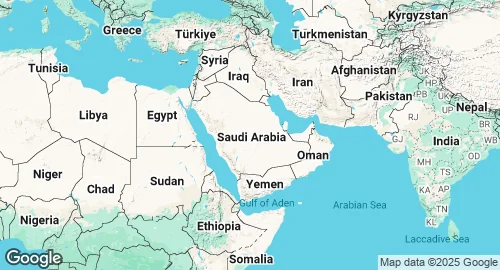Saudi Arabia Military Forces 🇸🇦
Military Strength Overview
| 🛩️ Air Force | 917 active aircraft |
| ⚓️ Naval forces | 34 ships in fleet |
| 🪖 Active Troops | 257,000 personnels |
| 👮♀️ Paramilitary | 24,500 personnels |
Defense Statistics & Key Metrics
| Population | 33.3 million (2023) |
| GDP | $1.1 trillion (2023) |
| GDP per capita | $32094 (2023) |
| Military Budget | $80.3 billion (2024) |
| Share of GDP in Milex | 7.3% (2024) |
| Share of Govt Expenditures | 22.3% (2024) |
| Military spends per capita | $2387 (2024) |
| Inflation Rate | 1.69% (2024) |
| Military Personnel | 282,000 (2020) |
Strategic Overview in 2025
Saudi Arabia stands as a dominant military power in the Middle East, a position reinforced by one of the world's largest defense budgets. For 2025, Riyadh has allocated $80 billion to defense, representing ~7% of its GDP. This significant financial commitment fuels a comprehensive modernization of its armed forces and supports an assertive foreign policy aimed at protecting its national interests and countering regional rivals.
Military Structure and Capabilities
The Royal Saudi Armed Forces consist of the Royal Saudi Army, Royal Saudi Navy, Royal Saudi Air Force, Royal Saudi Air Defense, and the Royal Saudi Strategic Missile Force. These are supplemented by the Saudi Arabian National Guard, a separate entity under the Ministry of National Guard. The total active military personnel is estimated around 250k in 2025.
The army's strength is built around a core of French and American armored vehicles, including M-1A2 Abrams tanks, M-2 Bradley fighting vehicles, and over 7,000 other armored vehicles. The Royal Saudi Air Force is a technologically advanced service, operating a fleet of F-15SA and Eurofighter Typhoon combat aircraft, with ongoing upgrades and procurement programs. The navy operates two fleets, in the west and east, with a focus on guided-missile frigates, corvettes, and coastal defense. Saudi Arabia also possesses a strategic deterrent in the form of Chinese-made DF-3A (CSS-2) intermediate-range ballistic missiles.
Strategic Alliances and Modernization
Saudi Arabia's military posture is heavily reliant on its strategic partnership with the United States. A landmark defense agreement signed in May 2025, valued at $142 billion, underscores this relationship. The deal focuses on the modernization of Saudi military equipment across all domains, including upgrading the F-15SA fleet, enhancing the Patriot PAC-3 MSE missile defense system, and improving C4ISR capabilities to ensure interoperability with US forces. The Kingdom also maintains defense ties with other nations, including the United Kingdom, France, and increasingly, Turkey.
Current and Foreseeable Strategic Trends
A key strategic trend is the push for self-reliance in the defense sector, a central pillar of the Kingdom's Vision 2030. The government aims to localize over 50% of its military spending by 2030, fostering a domestic defense industry through entities like Saudi Arabian Military Industries (SAMI). This initiative seeks to reduce dependence on foreign imports and build indigenous capabilities in manufacturing and innovation. Geopolitically, Saudi Arabia's military strategy is shaped by ongoing regional tensions, the need to secure vital energy infrastructure, and the evolving threat landscape that includes ballistic missiles and drone warfare. The Kingdom is also expanding its unmanned aerial vehicle capabilities to address these challenges.
Saudi Arabian Military Budget History
Population and Military Personnel Trends
GDP and Inflation Rate Trends
Military Expenditure: SIPRI Milex.
